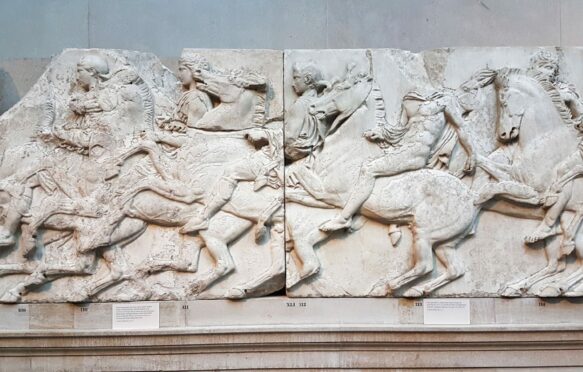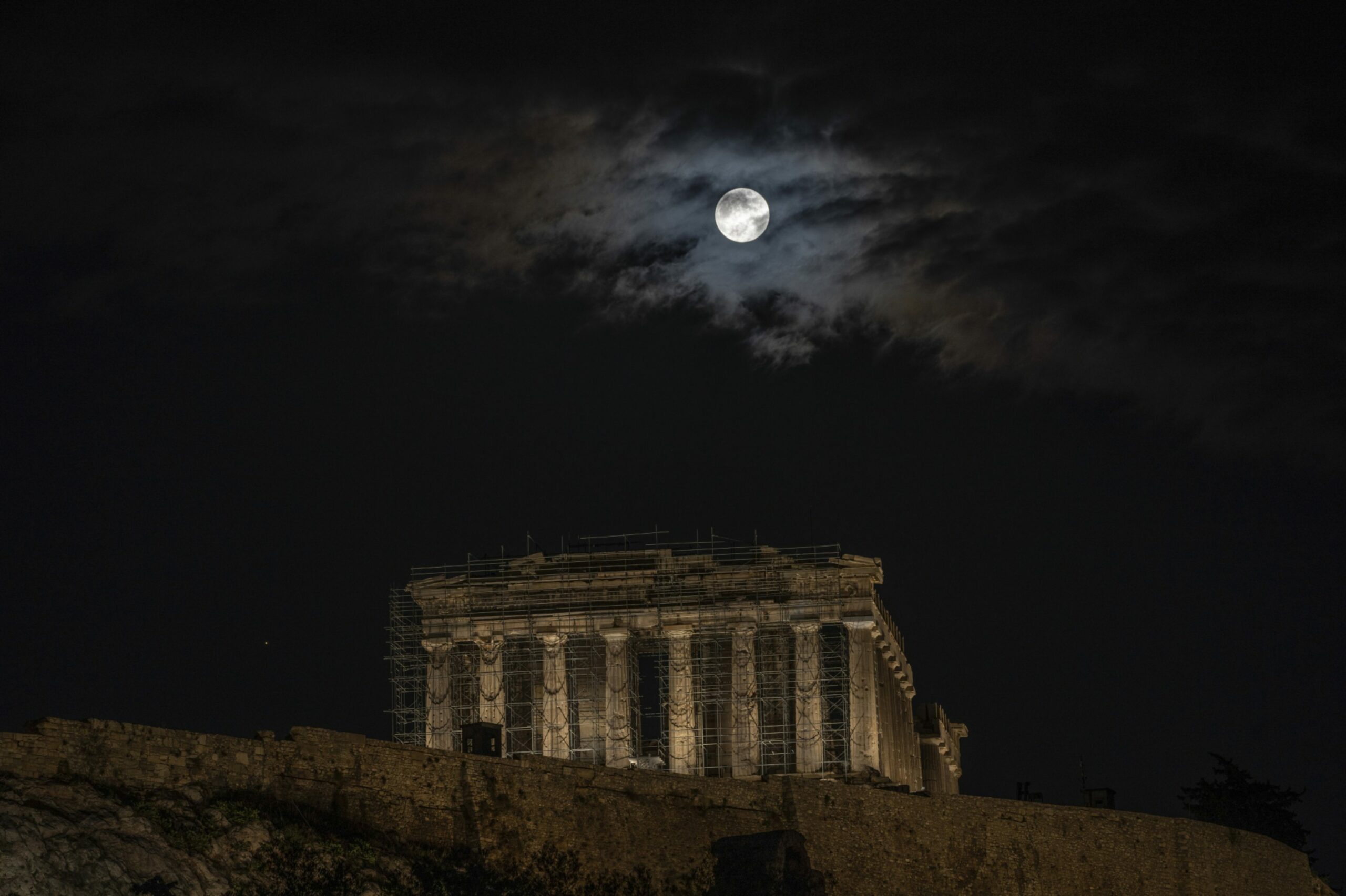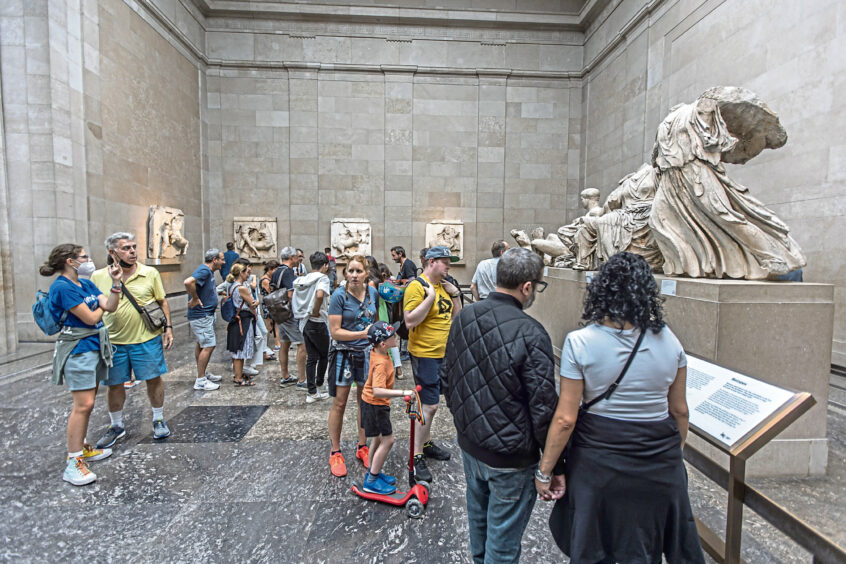
Damaged but beautiful, the Parthenon in Athens is a symbol of Greece.
It is a national icon that has stood since the 5th Century BC, surviving conquests, explosions and the ravages of time.
The spectacular marble statues, once integral to the splendour of the Parthenon have survived in parts and, while their past has been turbulent, their future is again uncertain as the debate over museum repatriations escalates.
Split around various parts of the world, opinion on where the intricate sculptures should be displayed remains just as fractured. Reports last week suggested former chancellor George Osborne, in his new role as chair of the British Museum, has been involved in lengthy but secret discussions with the Greek Government about the sculptures’ repatriation.
A collection of about half of them currently resides in the institution, having been looted or rescued – depending on who you ask – from the Greek capital by Thomas Bruce, 7th Earl of Elgin, in the early-1800s. The Fife aristocrat claimed he had an official decree to take them from Ottoman authorities, who controlled Athens at the time, but this has long been disputed.
After the issue was debated in parliament, the British Government paid £35,000 for what would become known as the Elgin Marbles in 1816, and they were entrusted to the British Museum in London, where they’ve been on display ever since.
But, as talks on a return to Athens are said to be at an advanced stage, Kyriakos Mitsotakis, the Greek Prime Minister, speaking at the London School of Economics last week, said: “A win-win solution can be found that will result in the reunification of the Parthenon sculptures in Greece, while at the same time taking into account concerns the British Museum may have.”
The museum, however, said it was “not going to dismantle our great collection as it tells a unique story of our common humanity”.
It added: “The debate about restitution raises important and nuanced questions around objects and collections which are looked after in many countries around the world. The British Museum fully acknowledges the complex histories of objects within the collection and recognises our responsibility to engage audiences about their interconnected history in the modern world.”
The ownership of the 2,500-year-old sculptures is one of the highest-profile debates surrounding the repatriation of important cultural objects held by museums, particularly those looted through imperialism, colonialism or war. Greece hopes to display the pieces held by the British Museum alongside those already in their possession and exhibited in the blank spaces awaiting them across the road from their original site in Athens.
Classical archaeologist professor Jenifer Neils, an expert on the Parthenon, believes that, while both sides have claims to ownership of the sculptures, their true home should be where they best “fulfil their noble mission of belonging to everyone”. That, she believes, is in Greece. “The biggest concern is what’s best for these unique and preeminent monuments,” she said.
“Physically, the best place is in Athens. That allows for the proper arrangement of all the blocks in order, seen as they would’ve been on the building from the outside, rather than inside.
“The new Acropolis museum built in 2009 is a state-of-the-art exhibition space as opposed to the pre-war Duveen Gallery in the British Museum.”
Neils compares the dispersal of pieces of the work, which was an integral part of The Parthenon, to “chopping up the Sistine ceiling”.“[The sculptures] weren’t just slapped on,” she said. “They were the fabric of the building.
“In order to understand the genius of somebody like the architect and sculptor Phidias and what he designed for this, we’d like to see it as complete as possible. The best way to do that is in the Acropolis Museum.
“They have the right setting for it, and other countries have given parts back. Putting it together would have a huge contribution to education and culture. It’ll be much more legible and the aesthetic value will also be even more evident. That’s key to the appreciation and reading of what is a 320-foot narrative.”
Neils does not believe Elgin to be the villain of the piece, and feels that, while returning the marbles to Greece would be morally correct, many ethical arguments over their stewardship are no longer relevant. “Morally it’s the right thing but not the most pressing argument,” she said. “Going back 200 years isn’t addressing the concerns of today.
“This is the flagship of repatriation but often for the wrong reasons. Everybody goes back and argues about Elgin. If he hadn’t taken them, the French probably would. It was so common. It was looting but was overlooked because the Ottomans were there. I don’t know if the Greeks would’ve stopped it either.”
Neils hopes, too, that any exhibition of the full work would be free for visitors to see. “They should adopt the same policy as the British Museum, which made them accessible, open six days a week and free,” she said. “That’s not the case with the Acropolis Museum, but I’d like to see that.”
An opinion poll earlier this year found 40% of British people would be in favour of returning the marbles, while 16% wanted them kept here.
But the culture secretary poured cold water on the idea of the marbles being returned, and the British Museum is currently not legally allowed to do so.
Michelle Donelan told a Commons committee it had the potential to be “a very dangerous and slippy road to embark down”. Repatriation is not unprecedented and increasingly common. In 1999 a Ghost Dance Shirt was returned by Glasgow Museums to the Lakota people. It had been taken from a body at the 1890 Wounded Knee Creek Massacre in South Dakota, where the US cavalry killed 150 Native Americans.
Last month, London’s Horniman Museum signed a deal to return 72 items, including so-called Benin Bronzes, to Nigerian ownership.
Many museums in the UK, including some of Scotland’s most famous galleries, are thought to still hold parts of a collection of thousands of brass plaques and carved ivory tusks looted from the Nigerian city in 1897 by British naval forces.
Isabel Ruffell, professor of Greek drama and culture at Glasgow University, is in no doubt the marbles, like many other treasures, should be returned. “One of the things people often worry about is that our museums would be denuded of material, they won’t have anything left, but there’s so much stuff that’s been dug up,” she said. “There’s lots to go round so it makes sense for the really central items to be where they belong.
On the marbles specifically, she said: “It is morally indefensible for them to be in London. It’s bizarre that you’ve got all these bits from the same building all over Europe.
These are iconic images of profound significance to the people of Greece. Their removal belongs to the smash-and-grab period of classical archaeology, which is intertwined with our colonial past, and we need to face up to that.
You’ve got these really high stakes pieces of sculpture that matter a great deal to one of our fellow European countries and it seems slightly peculiar that we’re not giving them back. It’s really quite childish in a way.”
She, too, believes the Acropolis Museum in Athens would be the best place to show the marbles in all of their glory. “From an educational point of view, the British Museum display is really unhelpful,” she said.
“The Panathenaic frieze is inside-out, and the other frieze elements dislocated in other ways. The display in Athens, which is waiting for their return, will display the surviving material in a way that is as close as possible to the original layout.
“It is a fabulous museum. It has really good displays of some of the other stuff that was on the site so you get a much better sense of what it was like – it was incredibly crowded. It’s not just the edited highlights, you see the whole lot. A lot of museums have big aesthetic treasures completely divorced from context.
“Having them in this austere white room in the British Museum is a very strange, misleading way of looking at it.
“As someone who has benefited from the school trip to London in my time, it is very educational and useful but you could do that with plaster cast or loans of material. I think museums are quite co-operative on the whole these days, so these kinds of things are not unprecedented, loan deals and plaster casts and so forth.
“If the goal here is to provide a resource to people to learn, which is what it should be, then there are ways of doing it without having to do the ‘it’s mine, you can’t have it back’ kind of thing.”

Enjoy the convenience of having The Sunday Post delivered as a digital ePaper straight to your smartphone, tablet or computer.
Subscribe for only £5.49 a month and enjoy all the benefits of the printed paper as a digital replica.
Subscribe © Shutterstock Feed
© Shutterstock Feed © Nicolas Economou/NurPhoto/Shutte
© Nicolas Economou/NurPhoto/Shutte